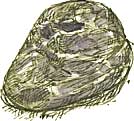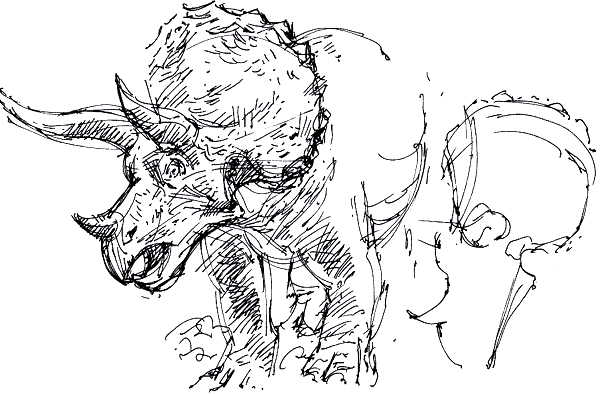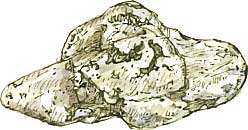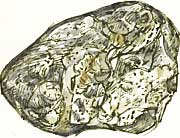 Gastroliths
Gastroliths Gastroliths
GastrolithsWild West Yorkshire, Sunday 14 November 2010
previous | this month | next

Triceratops drawn at the Carnosaur exhibition, Yorkshire Museum, October 1997

 OUR TEXAN friends, Rheba and Farris, who gave us these curious pebbles when we visited them a few years ago, told us that they'd found them on their land at The Lair, near Lampasas, north of Austin, Texas, and they'd had them confirmed as dinosaur gastroliths by a paleontologist. They're stones that were ingested by plant-eating dinosaurs to help break down their plant food which might have consisted of the tough leaves of ferns, horsetails and cycads. The stones were churned about in a muscular part of the digestive system - the equivalent of the gizzard in birds.
OUR TEXAN friends, Rheba and Farris, who gave us these curious pebbles when we visited them a few years ago, told us that they'd found them on their land at The Lair, near Lampasas, north of Austin, Texas, and they'd had them confirmed as dinosaur gastroliths by a paleontologist. They're stones that were ingested by plant-eating dinosaurs to help break down their plant food which might have consisted of the tough leaves of ferns, horsetails and cycads. The stones were churned about in a muscular part of the digestive system - the equivalent of the gizzard in birds.
It would be hard to think of another explanation for their origin. They're polished smooth but - particularly the one on the left - more irregular than your average beach or river pebble. They range from 5.5 to 7 cm in length. The largest (above left) and the one on the right appear to be flinty but I'd guess that the irregular one is some kind of limestone.
It's wonderful to have them on the desk as paperweights - everyday objects in my life - and to realise, as I feel the smooth polished surface of one of these pebbles in my hand, that it links me directly to the behaviour of a particular dinosaur which chose to swallow it on a particular day some 150 million years ago. The rock would have been more sharp-edged when ingested.
Richard Bell, illustrator
previous | this month | Wild West Yorkshire home page | next